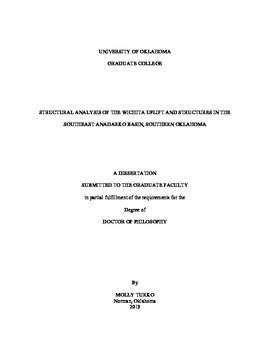| dc.contributor.advisor | Mitra, Shankar | |
| dc.contributor.author | Turko, Molly | |
| dc.date.accessioned | 2019-12-12T21:32:54Z | |
| dc.date.available | 2019-12-12T21:32:54Z | |
| dc.date.issued | 2019-12 | |
| dc.identifier.uri | https://hdl.handle.net/11244/322861 | |
| dc.description.abstract | Regional structural transects across the Wichita Uplift and adjacent Anadarko Basin show the relationship between thick-skinned basement-involved structures and thin-skinned detached fold-thrust structures. Slip from the basement-involved structures in the Wichita Uplift is transferred along two major detachments into the Anadarko Basin. Along the southwestern margin of the Anadarko Basin, the Wichita Uplift is marked by a zone of frontal imbricates forming a triangular wedge with most of the slip dissipated along the Wichita front. Paleozoic units show tight folding with overturned beds in the frontal zone. The uplift is episodic as indicated by the truncation of major faults along unconformities and their subsequent reactivation.
In contrast, the southeast margin shows that a significant part of the slip is transferred into structures in the basin. These structures are tight faulted-detachment folds that formed above a major detachment within the Springer Shale, cored by broader structures detaching at the base of the Arbuckle Group. Examples include the Carter-Knox, Cement, Chickasha, and Cruce structures. The faulted-detachment folds formed within the thin-bedded Pennsylvanian-age clastic units while the broad structures formed in pre-Pennsylvanian units dominated by thick carbonate units. These two main structural packages underwent differential, but simultaneous, shortening due to a forward-shear along the frontal faults of the Wichita Uplift.
Pre-existing normal faults of Precambrian-Cambrian age were either reactivated along the Wichita Uplift, or controlled the location of the Pennsylvanian age structures in the Anadarko Basin. Progressive rotation of regional stresses from NE-SW to a more ENE-WSW direction during the Pennsylvanian uplift influenced the tectonic history of the area. As the regional stresses rotated to ENE-WSW, the more E-W oriented structures in the Anadarko Basin were cut by strike-slip faults that linked down into the pre-existing normal faults. The strike-slip faults were accompanied by normal faulting with Virgilian-age sediments filling the accommodation space and indicating the timing of the strike-slip movement.
2D and 3D seismic, well log data, and surface geology were used to evaluate the structural styles of the Wichita Uplift and the Anadarko Basin, and allowed for an interpretation of the tectonic evolution of the region. | en_US |
| dc.language | en_US | en_US |
| dc.rights | Attribution 4.0 International | * |
| dc.rights.uri | https://creativecommons.org/licenses/by/4.0/ | * |
| dc.subject | Geology. | en_US |
| dc.subject | Structural Geology | en_US |
| dc.subject | Wichita Mountain Uplift | en_US |
| dc.subject | Anadarko Basin | en_US |
| dc.title | STRUCTURAL ANALYSIS OF THE WICHITA UPLIFT AND STRUCTURES IN THE SOUTHEAST ANADARKO BASIN, SOUTHERN OKLAHOMA | en_US |
| dc.contributor.committeeMember | Marfurt, Kurt | |
| dc.contributor.committeeMember | Pranter, Matthew | |
| dc.contributor.committeeMember | Devegowda, Deepak | |
| dc.contributor.committeeMember | Tapp, Bryan | |
| dc.date.manuscript | 2019-12-10 | |
| dc.thesis.degree | Ph.D. | en_US |
| ou.group | Mewbourne College of Earth and Energy::School of Geosciences | en_US |

